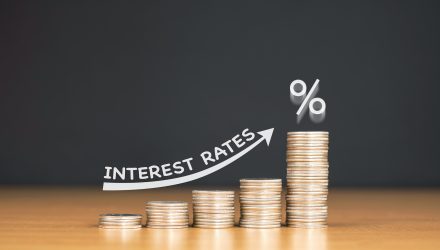Stocks and index ETFs were bathed in a sea of red on Tuesday, after Federal Reserve Chairman Jerome Powell hinted that the central bank could hasten the timeline to pull back its efforts to shore up the economy as it struggles with increasing inflation pressures.
In a meeting before a Senate committee, Powell said that he thinks slashing the pace of monthly bond buys could happen faster than the $15 billion a month schedule stated earlier this month, adding that he anticipates the issue to be addressed at the December Fed meeting.
“At this point, the economy is very strong and inflationary pressures are higher, and it is therefore appropriate in my view to consider wrapping up the taper of our asset purchases, which we actually announced at the November meeting, perhaps a few months sooner,” Powell said. “I expect that we will discuss that at our upcoming meeting.”
Although the initial tapering schedule projected that bond purchases would culminate around June, if the committee chooses to ramp up the process, that could mean a close earlier in the spring, giving the Fed the option to increase interest rates anytime thereafter.
Stocks and index ETFs, which rallied on Monday after a brutal decline to close last week amid news of the new coronavirus variant, Omicron, fell after Powell’s comments, while government bond yields surged.
Major stock ETFs that tumbled on Tuesday included the SPDR Dow Jones Industrial Average ETF (DIA), the SPDR S&P 500 ETF Trust (SPY), and the Invesco QQQ Trust (QQQ), which were all down more than 1.6% as of 12:30 PM EST.
Meanwhile, as stocks have been taking a beating recently and volatility is expanding, with the Cboe Volatility Index leaping nearly 20% alone on Tuesday, the decline has been a financial positive for contrarian stock players and inverse ETF investors.
The ProShares Short S&P 500 (SH) gained as much as 1.65% on Tuesday, while the other major indexes plummeted. Another highly leveraged ETF, the Direxion Daily S&P 500 Bear 3X Shares (SPXS) rallied 5% on Monday, catalyzed by its triple leverage.
“The stock market is laser focused on news flow tied to Omicron,” said Jim Paulsen, chief investment strategist for Leuthold Group. On Monday, “the rally was boosted by soothing reports from South Africa that its symptoms seemed to be mild, and this morning, it is being rocked by news from Moderna that Omicron could invalidate our existing vaccines and necessitate a new and improved vaccine which could take months to develop.”
“With the VIX volatility index surging to its highest level in months, it appears investors may be facing several days of outsized market gyrations,” added Paulsen.
The FOMC planned to cut its bond-purchase program by $15 billion a month, including $10 billion in Treasuries and $5 billion in mortgage-backed securities.
However, the post-meeting statement indicated that would be the case for November and December, but it also noted that it “is prepared to adjust the pace of purchases if warranted by changes in the economic outlook.”
Minutes from the meeting also indicated that committee members were ready to increase interest rates as well if inflation persists, something that likely spooked investors and markets amid already heightened tensions from the Omicron variant.
Powell said that the bond-buying, which the Fed uses to adjust monetary policy, and which has added $4.5 trillion to the Fed’s $8.73 trillion balance sheet, has been “supporting economic activity.”
“The need for that has clearly diminished as the economy has continued to strengthen, as we’ve seen continued significant inflationary pressures, and that’s why we announced that we would taper, and it’s why we’re now saying we’re going to discuss a somewhat faster taper at our next meeting,” Powell said.
Despite fear of surging interest rates however, Powell has insisted that the tapering should not be seen as an indication that rate increases are a certainty.
Markets are currently pricing in at least two 0.25% increases next year, and possibly a third by December, while the September projections from Fed officials suggested a more modest timetable. Those projections also will be revised next month.
Recent data has shown inflation running at its highest rate in more than three decades.
Fed officials have continued to insist that inflationary pressures are due to supply chain issues and are only “transitory,” a word that Powell defines as not leaving a lasting impact on the economy. The word appeared in the post-meeting statement, though the Chairman said that it’s probably not useful anymore.
“The word transitory has different meanings for different people. To many it carries a sense of short-lived. We tend to use it to mean that it won’t leave a permanent mark in the form of higher inflation,” Powell said. “I think it’s probably a good time to retire that word and try to explain more clearly what we mean.”
In an attempt to quell any concerns though, Powell promised that the Fed would be on guard to control inflation.
“You’ve seen our policy adapt and you’ll see it continue to adapt. We’ll use our tools to make sure that higher inflation does not become entrenched,” he said.
For more news, information, and strategy, visit ETF Trends.
